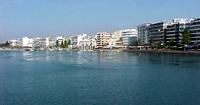

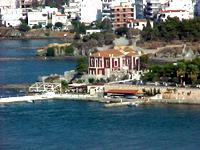
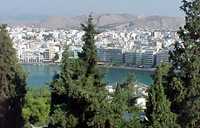
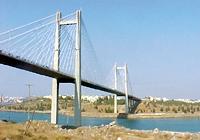
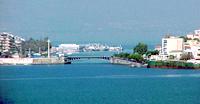
|
The earliest recorded mention of Chalkida
(also mentioned as "Halkida", "Halkis" and "Chalkis"), is
in the
Iliad (2.537), where it is mentioned in the same
line as its rival
Eretria. Chamber tombs at Trypa and Vromousa dated to
the
Mycenaean period were excavated by Papvasileion in
1910. In the
8th and 7th centuries BC, colonists from Chalkida founded
thirty townships on the peninsula of
Chalcidice, and several important cities in
Sicily. Its mineral produce, metal-work,
purple and pottery not only found markets among these
settlements, but were distributed over the
Mediterranean in the ships of
Corinth and
Samos.
With the help of these allies, Chalkida engaged the rival
league of its neighbour Eretria in the so-called
Lelantine War, by which it acquired the best
agricultural district of Euboea and became the chief city of the island. Early
in the
6th century BC, its prosperity was broken by a
disastrous war with the
Athenians, who expelled the ruling aristocracy and
settled a
cleruchy on the site. Chalkida subsequently became a
member of both the
Delian Leagues. In the Hellenistic period, it gained
inportance as a fortress by which the
Macedonian rulers controlled central Greece. It was
used by kings
Antiochus III of Syria (192
BC) and Mithradates VI of Pontus (88
BC) as a base for invading Greece.
Under Roman rule, Chalkida retained a measure of commercial
prosperity; since the 6th century AD it again served as a fortress for the
protection of central Greece against northern invaders. From
1209, it stood under Venetian control; in 1470 it passed to the
Ottomans, who made it the seat of a
pasha. In 1688, it was successfully held against a strong
Venetian attack.
The modern town received an impetus in its export trade
from the establishment of railway connection with Athens and Piraeus in 1904.
In the early 20th century it was composed of two parts — the old walled town
towards the Euripus, called the Castro, where the Jewish and
Turkish families who have remained there mostly dwell;
and the more modern suburb that lies outside it, which is chiefly occupied by
the Greeks. A part of the walls of the Castro and many of the houses within it
were shaken down by the earthquake of 1894; part has been demolished in the
widening of the Euripus. The most interesting object is the church of
St Paraskeve, which was once the chief church of the
Venetians; it dates from the Byzantine period, though many of its architectural
features are Western. In 1899, Chalkida became the prefectural capital of Euboea.
By now, Chalkida has about 60,000 inhabitants. The old
walls, near the Castro of Kara-Baba (Turkish word,
meaning "Black Father") near the sea no longer stand. The sizable Jewish community was
reduced after the World War II deportation. The town is now connected to
the mainland Greece by a new bridge in the southern and the western part.
|


